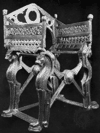throne, chair of state or the seat of a high dignitary. The throne was at first a stool or bench and later became an ornate armchair, usually raised on a dais and surmounted by a canopy. Often lavishly decorated, thrones have been made of a variety of materials, including wood, stone, ivory, and precious metals. Ancient Greek thrones were simple in form, with rectangular or curving legs and rosette adornments; they were adapted by the Etruscans, who made them more comfortable, and also by the Romans, who made them more ornate. The thrones of the East were usually more elaborate and fantastic in conception than those of Europe. In ancient times the Indian throne was a combined throne-altar, serving both a royal and a religious purpose. Thrones of the Renaissance in Europe were heavily ornamented with precious stones. Napoleon's throne was a gilded chair displaying eagles, lions, and other symbols. The throne of Great Britain is an oak chair in the House of Lords. At St. Peter's in Rome is the bronze papal throne designed by Bernini. The throne of a bishop is called a cathedra and the church in which it is maintained is thus a cathedral.
throne
The Columbia Electronic Encyclopedia® Copyright © 2007, Columbia University Press. Licensed from Columbia University Press. All rights reserved. www.cc.columbia.edu/cu/cup/
throne
Chair of state set on a dais and often surmounted by a canopy, representing the power of the dignitary who sits on it and sometimes conferring that power. In Greek history, thrones were identified as seats of the gods; soon the meaning of the word included the symbolic seats of those who held religious or secular power, a meaning common to virtually all cultures. The oldest surviving throne was built into the walls of Knossos (c. 1800 BC). Probably the most magnificent was the jewel-studded Peacock Throne of the rulers of Delhi, stolen from India by Persia in 1739 and thereafter the symbol of the Persian/Iranian monarchy. In the late 17th and 18th century, thrones were often made of silver, but later versions tend to be of gilded wood.
For more information on throne, visit Britannica.com. Britannica Concise Encyclopedia. Copyright © 1994-2008 Encyclopædia Britannica, Inc.
throne
1. the power, duties, or rank ascribed to a royal person
2. a person holding royal rank
3. the third of the nine orders into which the angels are traditionally divided in medieval angelology
Collins Discovery Encyclopedia, 1st edition © HarperCollins Publishers 2005
throne
seat of political or religious authority. [Western Folklore: Jobes, 1567]
See : Authority
Allusions—Cultural, Literary, Biblical, and Historical: A Thematic Dictionary. Copyright 2008 The Gale Group, Inc. All rights reserved.
How to thank TFD for its existence? Tell a friend about us, add a link to this page, add the site to iGoogle, or visit webmaster's page for free fun content.
Link to this page:
Please bookmark with social media, your votes are noticed and appreciated:
Ads by Google
Royal Wedding Appartments
500+ holiday apartments in London. Live the Royal Wedding like a local
www.housetrip.com/royal_wedding
500+ holiday apartments in London. Live the Royal Wedding like a local
www.housetrip.com/royal_wedding
Lens design software for
modeling & analysis your optical systems - TracePro & OSLO suite.
www.lambdares.com
modeling & analysis your optical systems - TracePro & OSLO suite.
www.lambdares.com
| Mentioned in | ? References in classic literature | |
|---|---|---|
At the foot of the throne these two parties separated and halted, facing each other at opposite sides of the aisle. Towards the throne they all strive: it is their madness--as if happiness sat on the throne At length the King, recovering from his astonishment at recognising the brother who had been lost some years before, exclaimed, 'Yes, you are indeed my brother, and now that I have found you, take thethrone to which I have no longer a right. |

